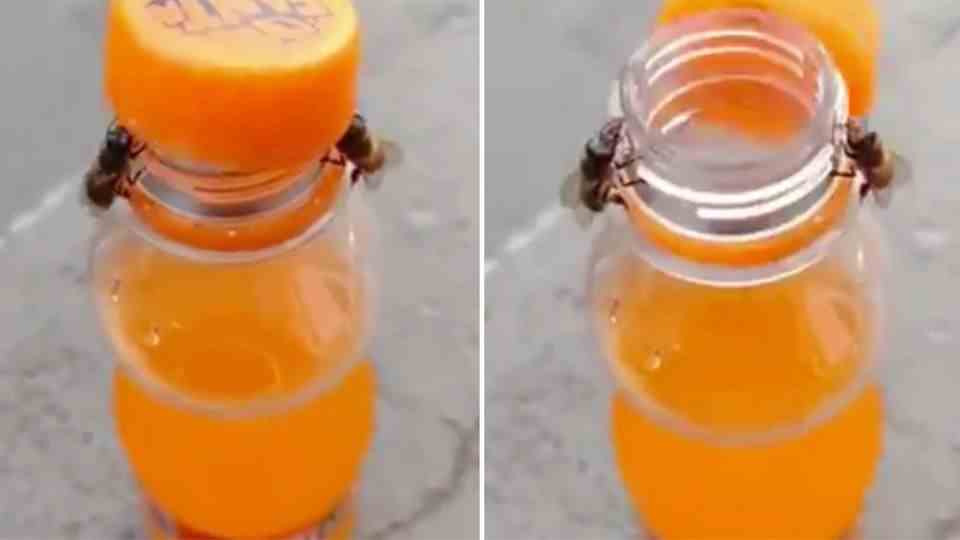bee deaths
Unwashed honey jars in the used glass container: death sentence for entire bee colonies
Bees not only make delicious honey, they are essential to the survival of humans and planet earth
© Koval Nadiya / Getty Images
Bee mortality is progressing worldwide. In addition to natural enemies such as parasites and mites, bacteria also pose a threat to bees. The pathogens spread by humans can wipe out entire bee colonies.
Unwashed honey jars in used glass containers or plastic packaging full of honey can pose a serious threat to local bee colonies. Bees that can no longer find flowers when foraging for food like to collect honey residue from human waste – and this is exactly where the problem lies.
Bacteria that may be lurking in contaminated honey residue are carried into the hive and can multiply there unhindered. An infestation with bacteria such as American foulbrood can mean the end of an entire bee colony or a beekeeper’s entire stock.
Bee plague is difficult to treat
American foulbrood (also known as vicious foulbrood) is a plague found among bee colonies around the world. Bee plague is caused by the bacterium Paenibacillus larvaelarvae, which affects the brood of honey bees. It is harmless to humans and other animals. Once in the hive, however, it can destroy entire bee colonies.
Contrary to what the name might suggest, the Malevolent Foulspawn is not native to America. The disease was only discovered there. A European variant, also called Benign Foulbrood, is said to be more harmless. Both bee diseases are difficult to treat.
The pathogen affects the offspring
The foulbrood pathogen gets into the beehive via contaminated honey – for example from the used glass container. There it is spread through physical contact and food exchange. It does not harm the adult bees, but only affects the offspring.
So-called nurse bees pass on food with spores of the pathogen to the larvae. The foulbrood enters the intestines of the bee larva. As soon as the honeycomb is capped, the bacterium multiplies rapidly. The larva is decomposed including the chitin skin. What remains is a slimy mass that dries to form a dark crust.
Spread beyond a colony
According to the Bavarian State Institute for Viticulture and Horticulture, around 2.5 billion pathogens can be detected per dead larva. So-called cleaner bees distribute these spores from the crust of the honeycomb throughout the hive. Further offspring are then infected through physical contact or infected food. Flying bees can also spread the pathogen during robbery in other hives.
A colony of bees without offspring becomes weaker and weaker. It is not uncommon for weakened bee colonies to be robbed or taken over by other colonies. These new, healthy bees pick up the pathogen from the contaminated hive and carry it into their own colony.
Measures against American foulbrood
A spread of foulbrood should be prevented at all costs. There are comprehensive measures that must be carried out according to the instructions of the official veterinarian: everything contaminated around the beehive must be disinfected or removed.
Depending on the severity of the infestation in a beehive and depending on the region, diseased colonies are killed or treated using a complex, special procedure until all spores have been eliminated. The measures always affect the entire colony or the entire bee population of a beekeeper, as transmission of the bacterium is very likely. Antibiotics only help to a limited extent, because they are powerless against the end spores.

Worldwide spread of the disease
The worldwide honey trade is the most common cause of infection of a bee colony with foulbrood. It is estimated that 80 to 90 percent of imported honey contains American foulbrood spores. This is because outside the EU, infected bee colonies are often treated with antibiotics. As a result, the bees remain healthy for the time being, but the spores of the pathogen are not combated.
The disease is particularly common in the vicinity of glass containers, landfill sites and motorway service areas, where bees like to collect honey if they cannot find flowers when foraging for food. Anyone who buys the mostly cheaper honey from other EU countries should rinse their honey jars or packaging thoroughly before disposing of them in order to protect the local bees. Alternatively, you can also use local honey.
Also read:
Sources:BR knowledge / Brilliant tricks / Animal epidemic info Lower Saxony



